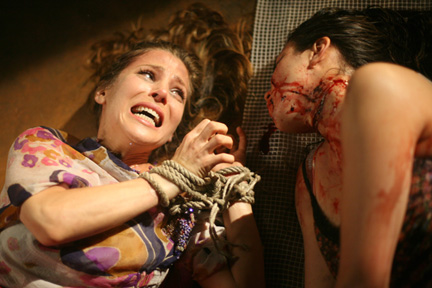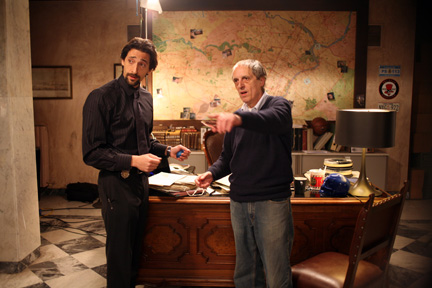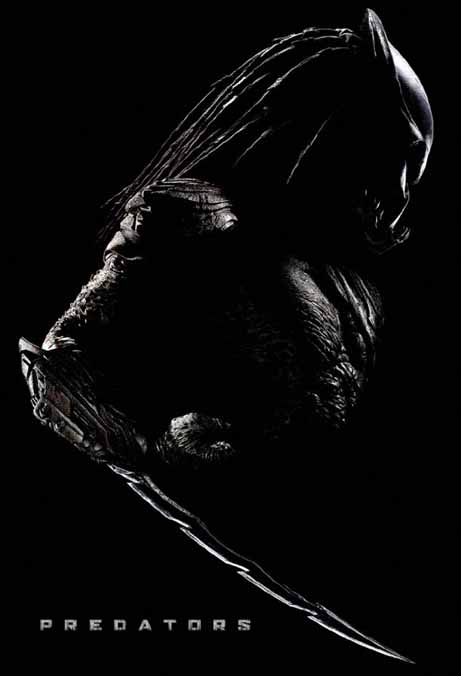An interview with Adrien Brody about his role in Robert Rodriguez’s PREDATORS from 20th Century Fox.
[serialposts]
Tag: Adrien Brody
More New Pics From Predators!
As if the ones yesterday weren’t enough, today we’re treated with even more pictures from the upcoming PREDATORS movie! Enjoy!










[serialposts]
New Pics From Predators!
Just released today, 3 new photos from the upcoming PREDATORS film, directed by Robert Rodriguez. We’re not sure what’s more scary: The Predator or Adrian Brody’s abs!



[serialposts]
Giallo (2009)
Marked by unpleasant violence and quesitonable humor, Argento’s latest thriller sees the director following his own dark muse, regardless of whether the audience tags along.
 Dario Argento’s films have always divided critical and audience opinions. To his supporters, he’s one of the cinema’s supreme visual stylists, his work further marked by a constant willingness to experiment with new technologies and techniques. To his detractors, there’s little substance to his films, which are also commonly accused of being badly written and acted and marred by gratuitous violence. Since around the time of PHENOMENA (1985) the detractors have assumed the upper hand, with even many of the director’s avowed fans asserting that his work just isn’t what it used to be.
Dario Argento’s films have always divided critical and audience opinions. To his supporters, he’s one of the cinema’s supreme visual stylists, his work further marked by a constant willingness to experiment with new technologies and techniques. To his detractors, there’s little substance to his films, which are also commonly accused of being badly written and acted and marred by gratuitous violence. Since around the time of PHENOMENA (1985) the detractors have assumed the upper hand, with even many of the director’s avowed fans asserting that his work just isn’t what it used to be.
They are right, but whether this represents an actual decline or the continuing creative evolution of Argento’s filmmaking is another matter. Much of the reason Trauma (1993), The Stendhal Syndrome (1995), The Phantom of the Opera (1998) and The Card Player (2004) do not appeal to fans weaned on the likes of The Bird with the Crystal Plumage (1970), Deep Red (1975) and Suspiria (1977) is that they do not conform to the expectations established by these early works. Take The Card Player: Amongst other things, it is deliberately, even excessively, restrained. The violent set piece, a main stock in trade of the director, is avoided to concentrate our attentions on the consequences of violence instead.
GIALLO (2009) is not going to settle these debates one way or the other. It does, however, fit with their general pattern – the main exceptions being the latter day crowd-pleaser Sleepless (2001) and would-be crowd-pleaser The Third Mother (2007) – by seeing Argento take his own dark path without paying much heed whether an audience is following.
The first thing about the film that must be addressed is its title. As is well-known, Giallo means “yellow” in Italian and has come to refer generically to a particular kind of horror-thriller, of which Argento’s earliest films established him as the leading practitioner. Given this and the highly self-referential approach taken by later works like Tenebre (1982), Opera (1987) and Do You Like Hitchcock (2005), we might expect GIALLO to offer more in the way of comment on the form than it does, perhaps even being prefaced by an explanatory definition of what giallo is in the manner of Tarantino’s Pulp Fiction. Instead, GIALLO is the nickname of the obligatory maniac. The name derives from his disfiguring skin condition, one that has left him fuelled with a hatred for beautiful young women. His modus operandi is to abduct them in his taxi, take them to his lair, and slowly mutilate them to death.
The other key dramatis personae are Celine (Elsa Pataky), Linda (Emmanuelle Seigner) and Inspector Enzo Avolfi (Adrien Brody). Celine is Yellow’s latest victim, Linda her sister. Avolfi is the enigmatic Manhunter-type figure assigned the case on a kind of ‘it takes one to know one’ or ‘poacher turned gamekeeper’ basis; the Thomas Harris reference seems appropriate given that the production company behind GIALLO is Hannibal [as in Lektor] Film.
 GIALLO’s key traits are violence and unpleasantness (arguably bordering upon the ‘torture porn’ variety), and humour. It is a rather uneasy combination, especially since it is not always particularly well signalled whether we are supposed to be laughing. In general, I feel that we are, that the film is intended as something of a self-parody. But even if this is the case, it is clear that Argento’s failure to make this crystal clear is detrimental to GIALLO’s overall effectiveness.
GIALLO’s key traits are violence and unpleasantness (arguably bordering upon the ‘torture porn’ variety), and humour. It is a rather uneasy combination, especially since it is not always particularly well signalled whether we are supposed to be laughing. In general, I feel that we are, that the film is intended as something of a self-parody. But even if this is the case, it is clear that Argento’s failure to make this crystal clear is detrimental to GIALLO’s overall effectiveness.
Two points of comparison come immediately to mind. The first is the aforementioned Phantom of the Opera, notable for Julian Sands’ mask-less, “rock star” Phantom and the general hostility it invoked among fans and non-fans alike. The second, suggested by Seigner’s presence, is Roman Polanski’s Bitter Moon (1992) – another of those “Is it intentionally ‘bad’, or just bad?” films.

There is some evidence for the ‘in-quotes’ position, though the fact that we have to look for it again points to the more fundamental problem. In particular, Brody’s ‘bad’ work has to be considered in the light of his Oscar-winning performance on Polanski’s The Pianist (2002), as a strong indication that he is one of the more capable actors Argento has collaborated with. And collaboration is the operative term here. Amongst Brody’s other roles was that of Executive Producer on GIALLO. As such, he and Argento had to have agreed upon the seemingly paradoxical over-the-top yet dead-pan way he was going to play things, for better or worse.
If a returning-the-favour reference to Juno is a throwaway, those to Japanese culture (a pre-Celine tourist victim; the hentai-type manga used by Yellow to fuel his perverse imaginings, and the more up-market volume of Araki art-or-porn photography purchased by Avolfi) may point to Argento’s growing interest here, as previously seen in the J-Horror, Gothic Lolita witch of The Three Mothers (2008). Or these references may be a way of trying to ensure distribution for GIALLO in Japan, traditionally an important marketplace for the director. Again, it’s up to the viewer to interpret, positively or negatively.
Visually, the film is middling Argento, more imaginative and stylish than most directors but hardly comparable to a Suspiria, Inferno (1980) or Opera. Aurally, it is less distinguished, with Marco Werba’s score lacking the memorable qualities of Ennio Morricone, Goblin or Claudio Simonetti’s work.
In sum, GIALLO is very much of a piece with the majority of Argento’s films of the later 1980s, 1990s and 2000s in its personal, take-it-or-leave-it nature. I took to it, but you may not. Whatever the case, hopefully you are at least in a position to make a better informed decision than a few hundred words ago.
[serialposts]
Splice: Cinefantastique Horror, Fantasy & Science Fiction Podcast 1:17

In Volume 1, Episode 17 of the Cinefantastique Horror, Fantasy & Science Fiction Podcast, Dan Persons Lawrence French, and Steve Biodrowski unravel the mysteries of genetic engineering and bad parenting as they analyze SPLICE, Vincenzo Natali’s thoughtful variation on the old “mad scientists create a monster” scenario. Also this week, the usual round-up of news, home video releases, and upcoming events.
Podcast: Play in new window | Download
[serialposts]
Splice: Science Fiction Film Review
Vincenzo Natali’s gene-splicing drama is this year’s MOON – a thoughtful little movie guaranteed to be the best filmed science fiction of the summer.
Serious cinematic science fiction is such a rarity these days that it sometimes seems like an endangered species, replaced by big-budget blockbusters about robots from outer space blowing stuff up; however, every once in a while a film arrives in theatres to remind us that thoughtful, intelligent genre cinema has not gone the way of the dinosaur. Last year, it was Duncan Jones’ MOON; this year, it is Vincenzo Natali’s SPLICE. In fact, I am going to go so far as to bestow virtually the exact same praise I lavished on MOON last year: I won’t say that SPLICE is guaranteed to be the best science fiction film of the summer (there may be other, even more engaging entertainments on the way), but strictly speaking, there can be little doubt that it will be this season’s best filmed science fiction – a motion picture that uses its premise to raise intriguing questions about the moral implications of scientific progress, without resorting to a simplistic formula about mad scientists and monsters run amok.
The story follows a pair of scientistswho splice genetic material from different animals to create hybrids that may provide cures to livestock diseases. Confronted by their corporate master’s decision to give up gene-splicing in favor of producing a patentable medicine, Elsa (Sarah Polley) and Clive (Adrien Brody) secretly take their experiment to the next level by including humans DNA in the mix. The resulting embryo grows at an unexpectedly accelerated rate, emerging as a strange – but surprisingly cute – little creature with wickedly poisonous tail. Clive wants to destroys the monster, but Elsa overrules him. As the creature matures it takes on more human characteristics, engendering a paternalistic reaction (for both good and bad) in the two scientists. Named Dren (“nerd” spelled backwards, N.E.R.D. being the acronym for Elsa and Clive’s company), the creature continues to move quickly through its life-cycle, rapidly reaching what looks like the equivalence of adolescence, including a dawning sexual interest in Clive.

With scientists named Clive (after Colin Clive who played the titular mad scientist in 1931’s FRANKENSTEIN) and Elsa (after Elsa Lanchester, who played the titular BRIDE OF FRANKENSTEIN in 1935), Nataliand co-screenwriter Antoinette Terry Bryant are clearly tipping their hat to classic horror films, but the inspiration for SPLICE seems to extend father back, all the way to the literary source novel by Mary Shelly. Although often pegged as science fiction, Shelly’s Frankenstein is almost totally bereft of science; it’s really more a metaphor for the hubris of a careless parent who begets life without considering the consequences. In the same way, SPLICE portrays Elsa and Clive less as mad scientists than as a pair of parents who cannot quite come to terms with their “problem” child.
The problem that Dren represents hangs over the film like a cloud, raising troubling moral questions that cannot easily be answered. Her existence leads to the isolation of the wished-for livestock medicine, but is that enough to justify an experiment that creates a new life form? Is Dren simply an experimental subject, to be terminated when the experiment is complete, or does her quasi-human nature grant her the same right to life that everyone else enjoys? What is the greater obligation for Elsa and Clive – to their scientific progeny or to the human race?

This last question is perhaps the most disturbing, because Dren, in the tradition of Frankenstein’s creation, elicits our sympathy even while we realize that she is potentially dangerous. And not just on a person-to-person level because of her lethal tail: she represents a new and unknown species, one that grows at an alarming rate; unleashed upon the world at large, there is no way of knowing how catastrophic the consequences may be.
Fortunately, these issues provide a solid thematic foundation without weighing down the story, which remains focused on Elsa and Clive’s struggle to negotiate the mess they have created – a mess that is partly scientific but also largely personal. Elsa never wanted to give birth herself, so this is her alternate method of having a child; unfortunately, she is burdened with the residue of an unhappy mother-daughter relationship, which starts to surface in her dealings with Dren. Clive is initially hostile to Dren, but as she matures, and as Else becomes less sympathetic to her “daughter,” Clive swings to Dren’s side.
With scientific objectivity thrown out the window, Elsa and Clive plunge into a personal psycho-drama of their own, fraught with jealousy and a power struggle, culminating in a sequence that is certain to be much remembered: Clive finally succumbs to Dren’s seductive charms. The vague hints of incest and bestiality (she is in a sense his daughter, and she is not fully human) provide an underlying ick factor to a scene that is otherwise filled with a mondo bizarro sense of wonder (sprouting wings, Dren looks almost as angelic as orgasmic), and yet as incredible as the action is, it remains grounded in a believable reality (Elsa catches them in the act – a scene that could occur in any domestic drama).
As a horror-thriller, SPLICE does not fully deliver on the promise of its trailers (which are cut together to suggest a more traditional monster-on-the-loose scenario). Dren is a fascinating character (a wonderful combination of CGI and Delphine Chaneac’s performance), but she is not as threatening as SIL in SPECIES. Natali does not build the tension to unbearable levels. Instead, he focuses on the drama, and the real horror of the piece is moral rather than visceral. The real triumph here is that, if you were to read about a real-life Elsa and Clive in a newspaper article, you would probably want them thrown in jail for life. By telling their story from the inside, Natali confronts you with some serious issues that are not easy to resolve. As we stride into the future, technology will force us to confront these same issues in real life. One of the important roles of the artist is to offer little signposts warning us of the future so that we may be prepared for when it arrives in reality. SPLICE does that better than any film since MOON.

SPLICE (2009). Directed by Vincenzo Natali. Written by Vincenzo Natali and Antoinette Terry Bryant and Doug Gaylor. Cast: Adrien Brody, Sarah Polley, Delphine Chaneac, Brandon McGibbon, Simona Maicanescu, David Hewlett, Abigail Chu.
[serialposts]
Splice trailer
Here is the first theatrical trailer for SPLICE, the low-budget science fiction film that got picked up for release by Warner Brothers after generating interest at the Sundance Film Festival in January. Adrien Brody and Sarah Polly play geneticists who create a new life form that winds up growing at an alarming (perhaps unstoppable rate). The film is scheduled to make its theatrical bow on June 4, in the middle of the summer blockbuster season. Can it hold its own against the likes of PRINCE OF PERSIA and TOY STORY 3?
[serialposts]
Predators theatrical release
 20th Century Fox releases the latest installment in the PREDATOR franchise. Robert Rodriguez produced the film, with Nimrod Antal directing from a screenplay by Alex Litvak & Michael Finch, based on the concept by Jim and John Thomas. Alice Braga, Topher Grace, Adrien Brody, and Laurence Fishburne lead the cast of elite warriors and killers from Earth, who are alien-abducted to a planet where they serve as game for the Predators. When you stop and think about it, only the very first PREDATOR movie was any good, and the ALIEN VS. PREDATOR films were just nonsense, but this premise is good enough to raise hopes, and the trailer does generate a buzz of excitement. Release date: July 9.
20th Century Fox releases the latest installment in the PREDATOR franchise. Robert Rodriguez produced the film, with Nimrod Antal directing from a screenplay by Alex Litvak & Michael Finch, based on the concept by Jim and John Thomas. Alice Braga, Topher Grace, Adrien Brody, and Laurence Fishburne lead the cast of elite warriors and killers from Earth, who are alien-abducted to a planet where they serve as game for the Predators. When you stop and think about it, only the very first PREDATOR movie was any good, and the ALIEN VS. PREDATOR films were just nonsense, but this premise is good enough to raise hopes, and the trailer does generate a buzz of excitement. Release date: July 9.
[serialposts]
Splice theatrical release

Warner Brothers releases this science fiction-horror film from director Vincenzo Natali (who impressed us greatly with his ’90s debut CUBE). The story follows a pair of scientists (Adrien Brody and Sarah Polley) who splice genetic material from different animals, including humans, to create a strange new highly intelligent creature known as Dren, who grows at an alarming rate. Natali co-wrote the script with Antoinette Terry Bryant and Doug Taylor. Guillermo Del Toro served as executive producer. SPLICE gained attention during its appearance at this year’s Sundance Festival, attracting the interest of Joel Silver, who picked it up for his Dark Castle Entertainment label and brought it to WB. Release date: June 4.
[serialposts]
